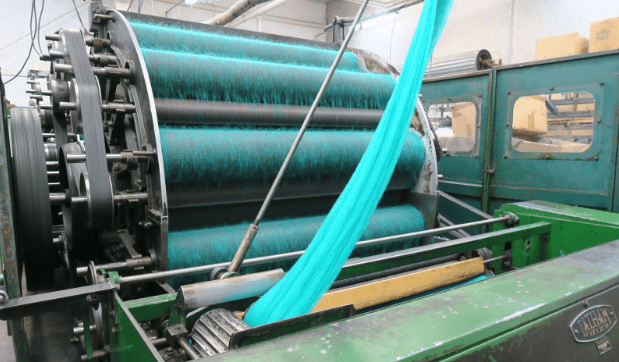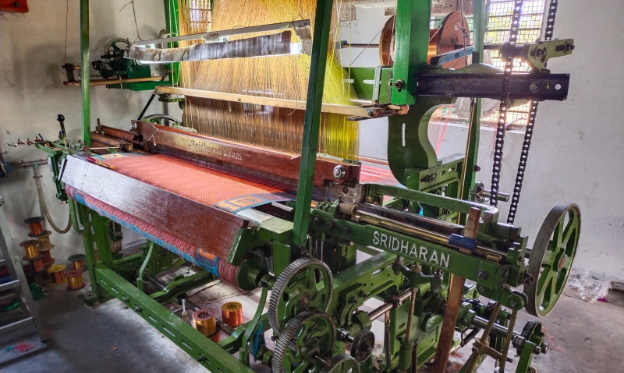By Tanvi Munjal
From the delicate threads we wear to the sturdy fabrics used in construction, the textile industry relies on a complex dance between intricate machinery and the utilities that power it. This cover story delves into the world of utility services and their critical role in maintaining the smooth operation of textile machines.
The Symphony of Utilities
 Within the world of textile machinery, a silent symphony plays out. It’s a performance where each element contributes to the smooth flow of production, ensuring consistent quality and efficiency. This symphony’s conductors are the essential utilities that power the machines, and each plays a distinct and crucial role:
Within the world of textile machinery, a silent symphony plays out. It’s a performance where each element contributes to the smooth flow of production, ensuring consistent quality and efficiency. This symphony’s conductors are the essential utilities that power the machines, and each plays a distinct and crucial role:
1. The Maestro: Electricity
Electricity is the lifeblood of the textile industry. It’s the invisible force behind every loom, spindle, and knitting machine. Reliable and stable electricity ensures:
- Uninterrupted Production: Power fluctuations can cause machines to stop or malfunction, leading to production delays and wasted materials. Consistent electricity flow keeps the rhythm of production steady.
- Consistent Yarn and Fabric Quality: Many textile processes rely on precise control of motor speeds. Fluctuations in electricity can lead to inconsistencies in yarn thickness and fabric quality.
- Versatility for Different Applications: Modern textile machinery utilises a wide range of motors with varying power requirements. A reliable electrical supply ensures the smooth operation of everything from high-powered weaving looms to delicate embroidery machines.
2. The Breath of Life: Compressed Air
Compressed air acts like the lungs of a textile operation. It provides the force for a variety of essential tasks, including:
- Pneumatic Conveying: Efficiently transporting raw fibres, yarns, and finished fabrics throughout the production line requires pressurised air to propel them through tubes.
- Machine Cleaning: Compressed air blasts are often used to remove dust, lint, and debris from machines, preventing build-up that could affect performance.
- Weaving Jets: In some weaving techniques, compressed air jets propel weft yarns through the warp threads at high speeds. Consistent air pressure ensures accurate placement and high-quality fabric formation.
- Other Applications: Compressed air plays a role in various other processes, from operating textile dyeing machines to powering tension control systems.
3. The Cleansing Elixir: Water
Water is a vital element throughout the textile production process. Its quality and availability are crucial for:
- Fibre Washing: Raw fibres often require washing to remove impurities like natural oils and dirt. Water quality in this stage impacts yarn quality and downstream processes.
- Dyeing and Finishing: The dyeing of fabrics relies heavily on water, and its quality directly affects colour vibrancy and consistency. Additionally, water is used in various finishing processes, such as washing away excess chemicals.
- Wastewater Treatment: The textile industry generates substantial wastewater. Proper treatment and management are essential for environmental protection and water conservation.
4. The Steely Hand: Steam
Steam provides the necessary heat for a variety of textile processes, including:
- Drying: Fabrics need to be dried efficiently after washing or dyeing. Steam provides a controlled and efficient drying method.
- Setting Dyes: Some dyes require heat to permanently set the colour onto the fabric. Steam plays a crucial role in achieving colourfastness.
- Finishing Processes: Steam can be used for setting wrinkles, shaping fabrics, and achieving specific textures.
The Importance of Harmony:
Like a symphony, all these utilities must work harmoniously to ensure smooth production. Fluctuations in pressure, temperature, or power can disrupt the rhythm and lead to costly problems.
Optimising the Symphony:
Modern textile plants are increasingly focusing on optimising utility usage:
- Energy Efficiency: Investing in energy-efficient motors, boilers, and compressed air systems can significantly reduce energy consumption while maintaining performance.
- Heat Recovery Systems: Capturing waste heat from processes like steam generation and reusing it for other purposes can improve efficiency.
- Water Conservation: Utilising water recycling and treatment technologies can minimise water usage and environmental impact.
Popular Textile Machinery, Utilities, and Maintenance
 The textile industry boasts a diverse range of machinery, each playing a specific role in transforming raw fibres into the fabrics we use daily. Let’s explore some popular machines, their utility needs, and essential maintenance practices:
The textile industry boasts a diverse range of machinery, each playing a specific role in transforming raw fibres into the fabrics we use daily. Let’s explore some popular machines, their utility needs, and essential maintenance practices:
1. Carding Machine

- Function: Opens and cleans raw fibres, removing impurities and aligning them for further processing.
- Utilities: Primarily electricity for powering motors.
- Maintenance: Regular cleaning of carding surfaces, lubrication of moving parts, and monitoring for worn-out components.
2. Ring Spinning Frame

- Function: Creates yarn by drawing, twisting, and winding fibres onto bobbins.
- Utilities: Electricity for motors and compressed air for cleaning.
Maintenance: Regular cleaning of drafting components, lubrication, and monitoring tension settings for consistent yarn quality.
3. Power Loom

- Function: Interlaces warp and weft yarns to create woven fabric.
- Utilities: Electricity for motors and compressed air for weft insertion (in some looms).
- Maintenance: Regular cleaning of shedding mechanism, lubrication of moving parts, and monitoring tension settings for even fabric formation.
4. Circular Knitting Machine

- Function: Creates tubular fabrics by knitting yarn in a continuous loop.
- Utilities: Electricity for motors and compressed air for yarn feeding (in some machines).
- Maintenance: Regular cleaning of needles, lubrication of moving parts, and monitoring yarn tension for consistent stitch formation.
5. Dyeing Machine
 Function: Applies colour to fabrics in a controlled environment.
Function: Applies colour to fabrics in a controlled environment.
- Utilities: Electricity for motors, water for processing, and steam for setting dyes (in some machines).
- Maintenance: Regular cleaning of tanks and pipes to prevent dye build-up, monitoring water quality to ensure consistent colour results, and checking steam pressure for proper dye setting.
The Utility Connection
Each machine has specific utility requirements to function optimally. Here’s a breakdown of how utilities are utilised:
- Electricity: Powers motors that drive various machine functions like rotation, movement, and pumping.
- Compressed Air: Provides force for cleaning, yarn feeding (in some machines), and weft insertion (in some looms).
- Water: Used in washing, dyeing, and finishing processes. Consistent quality and proper treatment are crucial.
- Steam: Provides heat for drying fabrics, setting dyes, and achieving specific textures.
The Art of Maintenance
 Maintaining this intricate web of utilities is as crucial as the machines themselves. A well-defined maintenance program ensures:
Maintaining this intricate web of utilities is as crucial as the machines themselves. A well-defined maintenance program ensures:
- Preventive Maintenance: Regular cleaning, lubrication, and inspection of machinery minimise breakdowns and extend equipment life.
- Predictive Maintenance: Utilising technologies like vibration analysis and oil sampling, potential issues can be identified and addressed before they escalate into major problems.
- Corrective Maintenance: When breakdowns occur, prompt repairs are essential to minimise downtime and production losses.
Skilled Personnel: The Secret Ingredient
The success of a textile operation hinges on skilled personnel who understand both the intricacies of the machinery and the vital role of utilities. Technicians play a critical role in:
- Monitoring utility performance: Keeping a watchful eye on pressure, temperature, and other parameters ensures efficient operation.
- Troubleshooting issues: Quickly identifying and resolving utility-related problems minimises production delays.
- Performing maintenance tasks: Following established procedures for cleaning, lubrication, and repairs keeps everything running smoothly.
The Future of Textile Maintenance
The future of textile maintenance is likely to see:
- Integration of Automation and Data Analytics: Utilising sensors and data analysis tools can provide real-time insights into utility performance, enabling predictive maintenance and optimising resource utilisation.
- Advanced Technologies: Condition monitoring systems and automation tools will further improve efficiency and reduce reliance on manual processes.
- Sustainability Focus: Optimising utility usage and minimising environmental impact will be a growing priority.
Conclusion
By ensuring a reliable flow of utilities and implementing a comprehensive maintenance program, textile manufacturers can keep their machines running smoothly, produce high-quality fabrics, and stay competitive in a dynamic global market. The unsung heroes – the utilities and the skilled personnel who maintain them – are the backbone of the textile industry, ensuring the threads that clothe the world are produced efficiently and sustainably.

